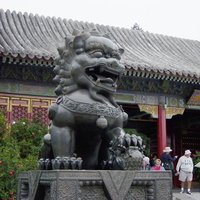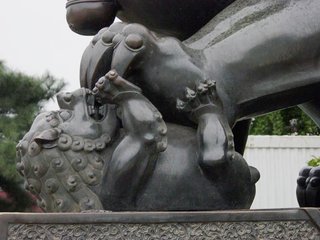Imperial guardian lions
|
|
Forbidden_City_Imperial_Guardian_Lions.JPG
Guardian lions, also called Fu Dogs, and called Shi (獅) in Chinese or Ra shi da, are powerful mythic protectors that have traditionally stood in front of Chinese imperial palaces, emperors' tombs and government offices. Since the Han Dynasty (206 BC-220 AD), imperial guardian lions were placed at the entrances to important official buildings and gates, until the end of the empire in 1911. They are still common, popularized as decorative and symbolic elements at the entrances to restaurants, hotels, and other structures.
The lions are generally present in pairs. To the intruder's right will be the male lion, with his right paw on a globe, representing his "feeling the pulse of the earth". To the intruder's left will be the female, essentially identical in appearance, but playing with her single cub with her left paw. The male of the pair is said to guard the structure, while the female fu dog protects those dwelling inside.
The lion is not indigenous to China. The mythic version of the animal was originally introduced to Han China as the Buddhist protector of dharma. Gradually they were transformed into guardians of the Imperial dharma and some Qing realizations of them came to look more like the dogs of Fo. (Compare the Pekingese breed.) These beasts have been found in art as early as 208 BC. In the Qing dynasty (1644-1911), the ruling Manchu derived their name from the Manjushri Buddha, who rides on a lion.
The beast is sometimes associated with feng shui or Buddhism. Fu means 'happiness' in Chinese. In China, they are known as Rui Shi (瑞獅).
Image gallery
FuDog.JPG


In the above gallery, note that the standing lion (a northern style nian) is wearing ornaments similar to those seen at the top of the article but does not have the shin armor.
Fu dog sometimes also refers to a breed of dog called Pekingese.
See also
- Lion dance, another use of lion imagery in costume and motion.
- Nian to compare with a similar but horned (unicorn) mythical beast
- Pixiu to compare with a similar but winged mythical beast
- Chinese mythology
External links
- World heritage immersive panorama (http://www.world-heritage-tour.org/asia/cn/beijing/gugong/shiZi.html) In this immersive panorama from the Imperial Palace Museum, Bejing, your viewpoint will be near a large bronze lion, the female whose male counterpart's image is in the gallery above, at the Gate of Supreme Harmony.
- A commercial webpage with some pictures of Fu Dogs (http://www.fengshuitips.co.uk/fu_dogs.htm)
- A webpage with pictures of a variety of Chinese stone lions (http://www.cjvlang.com/Photos/stonelion/stonelion.html).es:Perros de Fu


